7 Comments
Ten years ago, NIH launched the RePORT (Research Portfolio Online Reporting Tools) website to serve as a one-stop shop for reports, data, and analyses of NIH research activities. Well, drum roll please, a new and modernized RePORT site as well as a faster and easier to use NIH RePORTER have now arrived.
The updated RePORT site strives to meet the needs of today’s users based on feedback received over the years. It is easier, simpler, and quicker to access the same information you have come to rely upon. Right from the homepage, for instance, you can jump into data with interactive charts that connect out to NIH Data Book, RePORTER, and other resources.
And, that’s not all! NIH RePORTER has many new features too. Let’s take a closer look at some of them.
Quick Search
More than two-thirds of the searches on RePORTER look for a single investigator, institution, or grant number. Recognizing this, we moved from a crowded search form to a more inviting single search box that brings relevant results. Designed around the most frequently searched items, the quick search box automatically queries across multiple fields (Figure 1), returning relevant results for common queries. For those who still prefer RePORTER’s original precise search approach, it too will still be around (see below).
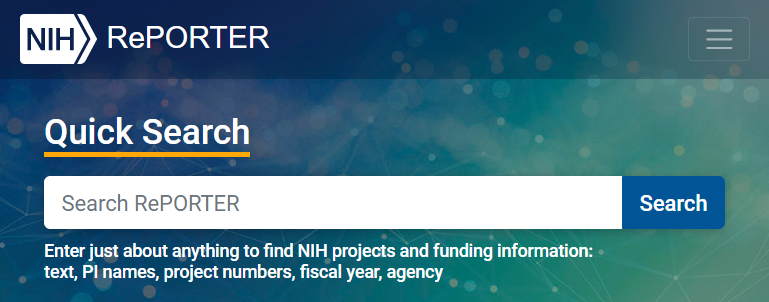
You can enter information like the research area, a name of an investigator, or the specific organization, and the system will match it with projects in RePORTER. The projects matching your query will be sorted by relevance, with those best matching your query shown at the top of the page. As with other popular search engines, you can refine your search by adjusting your terms directly on the page or by using the sidebar search filters (Figure 2 and below). The Active filter will show the projects that are currently ongoing.
Filterable results
Most screens in RePORTER will now offer filters that allow results to be refined without having to re-run the search (Figure 2). For instance, when searching for an organization or investigator name, you can make sure you are matching exactly the person you intended. Simply expand the filters on the left side of the search results page to focus the results to those projects of interest.
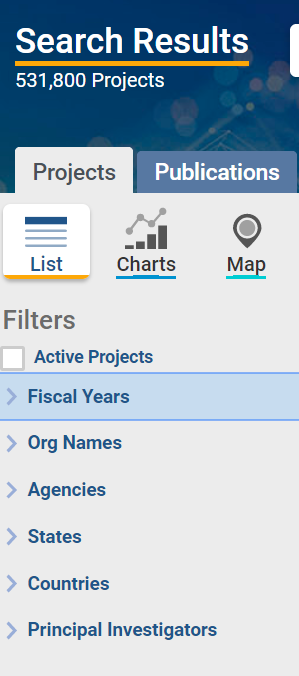
New Data Visualizations
For visitors who may not have a specific question or a keyword in mind, RePORTER now offers faster and more interactive graphs and charts on the homepage. This includes state map visualizations (Figure 3) and histograms displaying projects from multiple Institutes and Centers. These new entry points into RePORTER results take lessons learned from some of our other NIH RePORT web tools (as discussed on this NIH All About Grants podcast here).
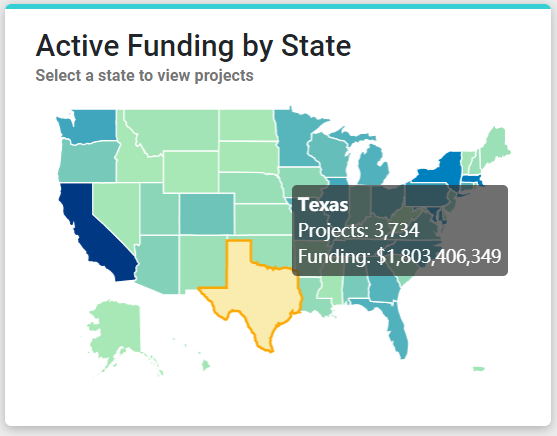
Single-page project details
The new design shows the same project-related information as the original Project RePORTER site. But now, it uses a single, smooth-scrolling page to easily scan all information about a project (Figure 4). The sidebar menu can also be clicked to jump directly to the project description, affiliated names and contact information, associated RCDC terms (see more here), and any resulting publications, clinical trials, and patents.
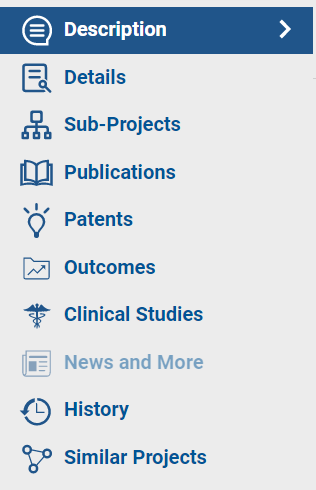
Advanced Project Search
If searching using precisely defined data fields is preferred, the new RePORTER site maintains the ability to conduct an advanced search similar to the original Project RePORTER site. Like searching for flights on travel sites, RePORTER advanced search allows careful selection of exactly your desired criteria. This view allows any searches to be set up that are currently allowed with RePORTER and save time with type-ahead autocomplete.
New search filters were also recently added to the original Project RePORTER site to easily and quickly identify awarded grant projects and supplements funded under special appropriations related to COVID-19 or under regular NIH appropriations (Figure 5). These search filters were carried over to the modernized RePORTER site for users to continue seeing what projects NIH is supporting in response to COVID-19.
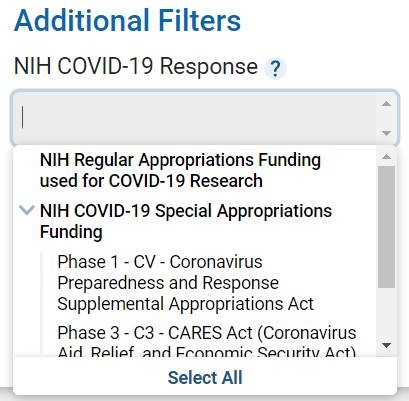
No Need for Bulk Downloads Anymore
A new application programming interface (API) is available for analysts and programmers to search, retrieve, and reuse NIH RePORTER data. Instead of downloading full sets of records in bulk through the ExPORTER files, the new NIH RePORTER API allows users to write computational procedures to retrieve just the grants data they need.
And, if that was not all, more Preview features will be rolled out in the coming year, like those for MyRePORTER. Tell us your thoughts as they come out.
We look forward to seeing what kind of searches people are looking to run and how your initial experience matches your expectations. If you have any feedback, please feel free to contact us by email to RePORT@mail.nih.gov, which will help us refine the system and ensure it continues to meet your needs today and into the next decade.



I always enjoy your updates, but had also relied heavily on the Biomedical Workforce Dashboard Web page. This has suddenly disappeared and multiple entreaties about its disappearance have gone unanswered. Any insights?
I believe this is what you might be searching for:
https://report.nih.gov/bmwdashboard/#/nih
In the section https://reporter.nih.gov/search/KwKm2faUY0et2E0F8TJV4w/project-details/10293947#similar-Projects
What algorithmare you using to find Similar Projects?
What type of algorithm? Sorry- I hit post too soon
NIH Matchmaker and Similar Projects features make use of the NIH RCDC thesaurus [https://report.nih.gov/funding/categorical-spending/rcdc-faqs#q5] to identify key scientific terms and their frequency within a text source, from which a ‘fingerprint’ is generated. A match score between any two fingerprints is determined via the cross product of the weights for the terms the two documents have in common.
I loved the old NIH reporter because I could look up what was being done Intramurally. How do we do that now?
NIH RePORTER offers the full set of advanced search features available previously. Scroll down to use the Advanced Search to the “Funding Mechanism” search item where you can select “Intramural Research.”